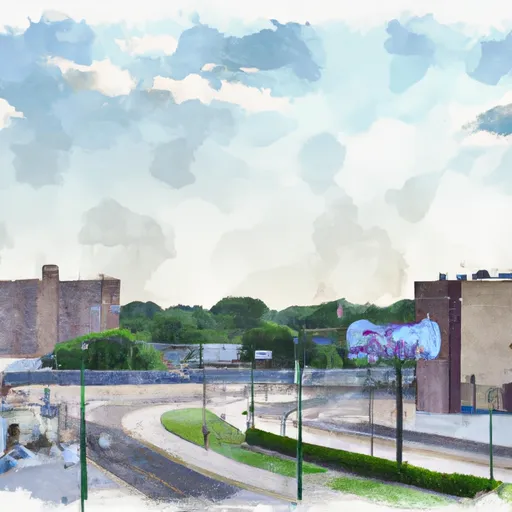-
 Snoflo Premium
Snoflo Premium
Get unlimited access to all our content
With no Ad interruptions! - Start Your Free Trial Login with existing account
Speedway
Eden Index
Climate
8.3
•
Recreation
2.8
•
Community
2.0
•
Safeguard
4.8/10

Speedway, Indiana is a small town located in Marion County, just northwest of downtown Indianapolis. The climate in Speedway is classified as humid continental, characterized by hot summers and cold winters. Summers are usually warm with temperatures ranging from the mid-70s to low 90s Fahrenheit, while winters can be quite cold with temperatures dropping to the teens and occasionally below freezing. The town experiences precipitation year-round, with rainfall averaging around 42 inches per year.
In terms of hydrology constituents, Speedway is not located near any major bodies of water. However, it is situated near White River, which flows just to the east of the town. This river system contributes to the hydrological makeup of the area.
For outdoor recreation enthusiasts, Speedway offers several opportunities. The town is home to the famous Indianapolis Motor Speedway, where the iconic Indianapolis 500 race takes place annually. Motorsports enthusiasts can enjoy various racing events and visit the museum to learn about the history of the sport. Additionally, there are local parks and recreational areas nearby, providing opportunities for hiking, picnicking, and sports activities.
What is the Eden Index?
The Snoflo Eden Index serves as a comprehensive rating system for regions, evaluating their desirability through a holistic assessment of climate health, outdoor recreation opportunities, and natural disaster risk, acknowledging the profound impact of these factors on livability and well-being.
Climate Health Indicator (CHI): 8.3
Speedway receives approximately
1035mm of rain per year,
with humidity levels near 82%
and air temperatures averaging around
12°C.
Speedway has a plant hardyness factor of
6, meaning
plants and agriculture in this region thrive during a short period during spring and early summer. Most
plants will die off during the colder winter months.
By considering the ideal temperature range, reliable water supplies, clean air, and stable seasonal rain or snowpacks, the Climate Health Indicator (CHI) underscores the significance of a healthy climate as the foundation for quality living.
A healthy climate is paramount for ensuring a high quality of life and livability in a region, fostering both physical well-being and environmental harmony. This can be characterized by ideal temperatures, reliable access to water supplies, clean air, and consistent seasonal rain or snowpacks.
Weather Forecast
Streamflow Conditions
Patoka-White
Area Rivers
Patoka-White
Snowpack Depths
Patoka-White
Reservoir Storage Capacity
Patoka-White
Groundwater Levels
Recreational Opportunity Index (ROI): 2.8
The Recreational Opportunity Index (ROI) recognizes the value of outdoor recreational options, such as parks, hiking trails, camping sites, and fishing spots, while acknowledging that climate plays a pivotal role in ensuring the comfort and consistency of these experiences.
Access to outdoor recreational opportunities, encompassing activities such as parks, hiking, camping, and fishing, is crucial for overall well-being, and the climate plays a pivotal role in enabling and enhancing these experiences, ensuring that individuals can engage in nature-based activities comfortably and consistently.
Camping Areas
| Campground | Campsites | Reservations | Toilets | Showers | Elevation |
|---|---|---|---|---|---|
| Spring Mill State Park | 220 | 670 ft | |||
| Buffalo Trace Co Park | 64 | 803 ft | |||
| Walnut Creek Marina | 33 | 608 ft | |||
| Paynetown State Rec Area - Monroe Lake | 320 | 557 ft | |||
| Delaney Creek Park | None | 584 ft | |||
| Hardin Ridge | 200 | 780 ft | |||
| Brown County State Park | 430 | 899 ft | |||
| OBannon Woods State Park | 280 | 784 ft | |||
| Starve Hollow State Rec Area | 200 | 552 ft | |||
| Yellowwood State Forest | 80 | 613 ft |
Nearby Ski Areas
Catastrophe Safeguard Index (CSI):
The Catastrophe Safeguard Index (CSI) recognizes that natural disaster risk, encompassing floods, fires, hurricanes, and tornadoes, can drastically affect safety and the overall appeal of an area.
The level of natural disaster risk in a region significantly affects safety and the overall livability, with climate change amplifying these risks by potentially increasing the frequency and intensity of events like floods, fires, hurricanes, and tornadoes, thereby posing substantial challenges to community resilience and well-being.
Community Resilience Indicator (CRI): 2.0
The Community Resilience Indicator (CRI) recognizes that education, healthcare, and socioeconomics are crucial to the well-being of a region. The CRI acknowledges the profound impact of these elements on residents' overall quality of life. By evaluating educational resources, healthcare accessibility, and economic inclusivity, the index captures the essential aspects that contribute to a thriving community, fostering resident satisfaction, equity, and social cohesion.

